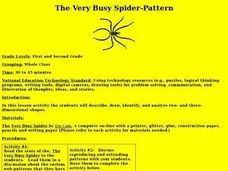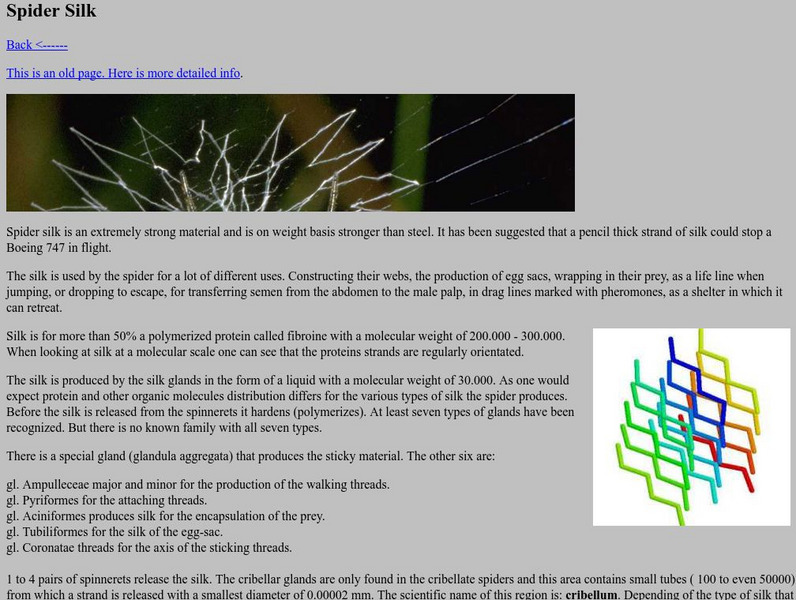Houghton Mifflin Harcourt
Nature Walk: English Language Development Lessons (Theme 2)
Walking in nature is the theme of a unit designed to support English language development lessons. Scholars look, write, speak, and move to explore topics such as camping, woodland animals, instruments,...
Curated OER
BrainStorming
Students, through modeling and independent practice, are introduced to the different methods of brainstorming. They explore and engage in these different approaches individually, in pairs, and as a group.
Curated OER
Governance
Second graders practice decision making. In this government lesson students role play making different types of decisions. They discuss how decisions affect life. The Great Binding Law of the Iroquois Confederacy is used as a focus.
Curated OER
Prairie Food Chains & Webs
Students complete a food chain. In this ecosystem lesson, students learn about producers, consumers and decomposers. Students identify herbivores, carnivores and omnivores and complete two worksheets.
Curated OER
Everything Grows
First graders read about the growth of living things. In this similiarities and differences lesson, 1st graders list things that are similiar and different about growing plants. Students then use a graphic organizer to list the...
Curated OER
Food Chains and Webs
Students create food chains. In this energy and food chains lesson, students discuss the importance of energy and food in survival of all animals. Students complete a grab bag research activity, construct food chains, and discuss...
Curated OER
Webs and Spiders
Students see how a spider spins her webs. They use yarn, pipe cleaners, eyes and glue to make the spider. For the web, students stand in a circle. They throw the ball of yarn across the circle. This begins the nice web shape. Students...
Curated OER
Getting Caught In The Web
Sixth graders brainstorm the ways a person's actions can affect a community. As a class, one classmate is given a ball of yarn and pass it along to another student creating a web. Next, some classmates are asked to drop their part and...
Curated OER
Critical Thinking & Writing: Brainstorming
Have your young writers organize their thoughts before writing. They generate ideas through various brainstorming activities prior to writing a mock feature news story for USA Today. A series of USA Today articles debating the level of...
Curated OER
Killer spiders invade Sydney!
Ninth graders examine the issue of killer spiders in Sydney, Australia. In this Sydney history lesson students read an article and answer guided reading questions. Students complete a quiz with a partner on the information that they...
Curated OER
The Very Busy Spider-Pattern
Students explore two- and three-dimensional shapes. In this very busy spider lesson, students read the story and then create a spider web pattern of their own. The webs must use a symmetrical pattern. Additional activities...
Curated OER
Writing: Planning Your Writing Worksheet 2--Example 2
In this brainstorming worksheet, students create a spider diagram by placing themselves in the middle and making branches with all the things they enjoy doing or phrases describing themselves.
Curated OER
Semantic Webbing
Students reflect upon the last four weeks in a review session involving semantic webbing. They offer opinions, likes, and dislikes about the lesson. They will discuss the instruction and evaluate the information presented.
Curated OER
Halloween Bulletin Board
Students create a halloween bulletin board. In this art lesson, students spread spider web over orange paper and glue spiders on the webbing.
Curated OER
Weather Poems
In this weather learning exercise, students use the pictures illustrated to help them unscramble each word to learn a few weather sayings. Then they identify the ways in which meteorologist tracked weather before technology.
Curated OER
Web of Life
Students work together to create a web of life. In groups, they put on nametags and form a circle. They toss the ball to a random person in the group and they make a connection between the person throwing the ball and the person...
Curated OER
Get Out of the Box
Third graders think outside the box with this instructional activity in organization through webbing. After a lecture/demo, 3rd graders utilize a worksheet imbedded in this plan which guides them through creating a writing web.
Other
Bucks County Community College: Visual Organizers
This site walks you through the benefits of visual organizers, and focuses on a variety of types: tables, charts, graphs, timelines, flowcharts, diagrams, and webs.
Other
Greg Freeman: Brainstorming Web
Greg Freeman gives an example and explanation of the graphic diagram called "brainstorming web." Includes suggestions for effective use, working strategies, and useful links.
Wisconsin Response to Intervention Center
Wisconsin Rt I Center: Semantic Maps for Word Learning [Pdf]
Classroom teachers will learn about semantic maps, an engaging instructional strategy tool. Teachers will learn how to implement semantic maps, understand how to measure progress with semantic maps, find research that supports semantic...
Other
Ed Nieuwenhuys' Spiders & Immunology: Spider Silk
An informative site on the properties of spider silk, including its surprising strength and how it's produced.





















![Wisconsin Rt I Center: Semantic Maps for Word Learning [Pdf] Professional Doc Wisconsin Rt I Center: Semantic Maps for Word Learning [Pdf] Professional Doc](https://d15y2dacu3jp90.cloudfront.net/images/attachment_defaults/resource/large/FPO-knovation.png)
